

Auditory Processing Disorder International Research. Abnormal auditory and language pathways in children with 16p11.2 deletion. Highlights We examined auditory and language white matter tracts in children with the 16p11.2 BP4–BP5 deletion.
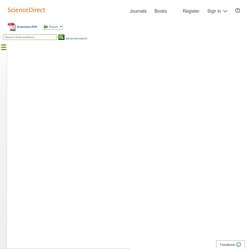
Diffusivity was enhanced in auditory radiation and arcuate fasciculus. Arcuate fasciculus microstructure was correlated with language ability in deletion carriers. There are correlations in the brain structure and behavioral phenotype in the 16p11.2 deletion carriers. Abstract Copy number variations at chromosome 16p11.2 contribute to neurodevelopmental disorders, including autism spectrum disorder (ASD). Abbreviations AD, axial diffusivity; ASD, autism spectrum disorder; CELF, clinical evaluation of language fundamentals; CNV, copy number variation; DTI, diffusion tensor imaging; FA, fractional anisotropy; GFA, generalized fractional anisotropy; HARDI, high angular resolution diffusion imaging; MD, mean diffusivity; RD, radial diffusivity Keywords.
A Behavioral Framework to Guide Research on Central Auditory Development and Plasticity. Altered Low-Gamma Sampling in Auditory Cortex Accounts for the Three Main Facets of Dyslexia. Figure 1 Stimulus' Waveform and Spectrogram (A) Waveform of the stimulus used to elicit auditory steady-state responses.

The stimulus is a 5.4 s amplitude modulated (AM) noise with AM linearly increasing from 10 to 80 Hz. (B) Spectrogram of the stimulus. See also Figure S1 . A review and synthesis of the first 20years of PET and fMRI studies of heard speech, spoken language and reading. Open Access Abstract The anatomy of language has been investigated with PET or fMRI for more than 20 years.

Here I attempt to provide an overview of the brain areas associated with heard speech, speech production and reading. The conclusions of many hundreds of studies were considered, grouped according to the type of processing, and reported in the order that they were published. Many findings have been replicated time and time again leading to some consistent and undisputable conclusions. Auditory and visual stream segregation in children and adults: An assessment of the amodality assumption of the ‘sluggish attentional shifting’ theory of dyslexia.
Research Report a Laboratoire de Psychologie et Neurocognition (UMR CNRS 5105), Grenoble, Franceb Université Pierre Mendès France, BP 47, 38040 Grenoble Cedex 9, Francec Université de Savoie, BP 1104, 73011 Chambéry Cedex, Franced Centre National de la Recherche Scientifique (CNRS, UMR 5105), Grenoble, Francee School of Psychology, University of Wales, Bangor, UKf Unité de Rééducation Neuropédiatrique, Hôpital Bicêtre, 94 275 Le Kremlin Bicêtre, France Accepted 15 July 2009, Available online 23 July 2009 Choose an option to locate/access this article: Check if you have access through your login credentials or your institution Check access doi:10.1016/j.brainres.2009.07.037.
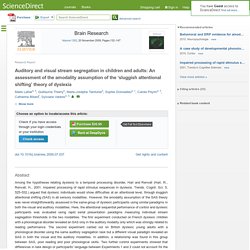
Auditory attention in childhood and adolescence: An event-related potential study of spatial selective attention to one of two simultaneous stories. Open Access Highlights We measured auditory ERPs in children ages 3–16 years using a naturalistic dichotic listening task.
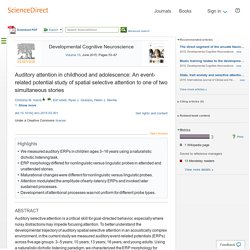
ERP morphology differed for nonlinguistic versus linguistic probes in attended and unattended stories. Maturational changes were different for nonlinguistic versus linguistic probes. Attention modulated the amplitude of early-latency ERPs and invoked later sustained processes. Development of attentional processes was not uniform for different probe types. Auditory Cortex Mapmaking: Principles, Projections, and Plasticity. Maps of sensory receptor epithelia and computed features of the sensory environment are common elements of auditory, visual, and somatic sensory representations from the periphery to the cerebral cortex.
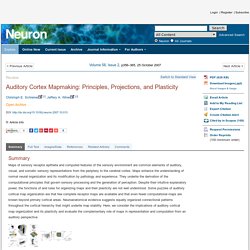
Maps enhance the understanding of normal neural organization and its modification by pathology and experience. They underlie the derivation of the computational principles that govern sensory processing and the generation of perception. Despite their intuitive explanatory power, the functions of and rules for organizing maps and their plasticity are not well understood. Some puzzles of auditory cortical map organization are that few complete receptor maps are available and that even fewer computational maps are known beyond primary cortical areas.
Neuroanatomical evidence suggests equally organized connectional patterns throughout the cortical hierarchy that might underlie map stability. Auditory critical periods: A review from system’s perspective. Auditory processing disorder evaluations and cognitive profiles of children with specific learning disorder. 1.
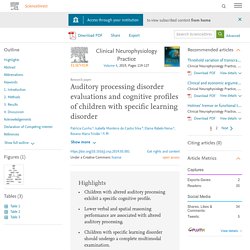
Introduction Specific learning disorder (SLD) is related to difficulties in learning and in the use of academic skills (American Psychiatry Association [APA], 2013). At least one symptom among comprehending difficulties in reading, writing, and academic skills must be present for a definite diagnosis. Auditory processing, speech perception and phonological ability in pre-school children at high-risk for dyslexia: A longitudinal study of the auditory temporal processing theory.
A Centre for Disability, Special Needs Education and Child Care, Katholieke Universiteit Leuven, Belgiumb ExpORL, Department Neurosciences, Katholieke Universiteit Leuven, Belgium Received 29 June 2006, Revised 9 January 2007, Accepted 10 January 2007, Available online 16 January 2007 Choose an option to locate/access this article: Check if you have access through your login credentials or your institution Check access doi:10.1016/j.neuropsychologia.2007.01.009.
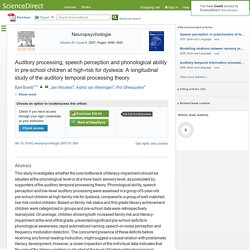
Auditory symptoms and psychological characteristics in adults with auditory processing disorders. Most adults with auditory processing disorder (APD) often have trouble at work.
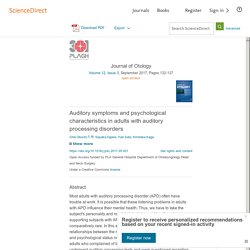
It is possible that these listening problems in adults with APD influence their mental health. Thus, we have to take the subject's personality and mental status into consideration when supporting subjects with APD. However, studies on APD in adults are comparatively rare. Context-Dependent Encoding in the Human Auditory Brainstem Relates to Hearing Speech in Noise: Implications for Developmental Dyslexia.
Figure 1 Stimulus Characteristics and Experimental Design (Top) The spectrogram of the stimulus /da/.

The boundary of the consonant-vowel formant transition and the steady-state vowel portion of the syllable is marked by a dashed white line. The spectrogram was generated via frequency analyses over 40 ms bins starting at time 0, and the midpoint of each bin is plotted. The stimulus /da/ is presented in variable (middle) and repetitive (bottom) contexts. Figure 2. Deciphering auditory processing disorders in children. Decreased temporal precision of neuronal signaling as a candidate mechanism of auditory processing disorder. Open Access Highlights In mouse models of central deafness and APD the cochlea is intact. Hearing crucially depends on short first spike latencies (FSL) and low jitter. Lack of synchronized firing may underlie deafness in the quivering mouse model. Dyslexia risk gene relates to representation of sound in the auditory brainstem.
<div class="msgBox" style="margin-top:10px;"><span class="errMsg"><div>JavaScript is disabled on your browser. Please enable JavaScript to use all the features on this page. This page uses JavaScript to progressively load the article content as a user scrolls. Click the View full text link to bypass dynamically loaded article content. <a rel="nofollow" href=" full text</a></div></span></div><br /> Exploring the role of auditory analysis in atypical compared to typical language development.
Impairments of multisensory integration and cross-sensory learning as pathways to dyslexia. Review a The Sheryl and Daniel R. Tishman Cognitive Neurophysiology Laboratory, Children's Evaluation and Rehabilitation Center (CERC), Department of Pediatrics, Albert Einstein College of Medicine, 1225 Morris Park Avenue, Van Etten Building – Wing 1C, Bronx, NY 10464, USAb The Dominick P. Intertrial auditory neural stability supports beat synchronization in preschoolers. <div class="msgBox" style="margin-top:10px;"><span class="errMsg"><div>JavaScript is disabled on your browser.
Please enable JavaScript to use all the features on this page. This page uses JavaScript to progressively load the article content as a user scrolls. Click the View full text link to bypass dynamically loaded article content. <a rel="nofollow" href=" full text</a></div></span></div><br /> Volume 17, February 2016, Pages 76–82 Special Section: The Developmental Neuroscience of Adolescence: Revisiting, Refining, and Extending Seminal Models. Left ear advantage in speech-related dichotic listening is not specific to auditory processing disorder in children: A machine-learning fMRI and DTI study. Asha. Maturation of auditory neural processes in autism spectrum disorder — A longitudinal MEG study. Mismatch negativity in children with specific language impairment and auditory processing disorder.
Multi-sensory learning and learning to read. Neural correlates of temporal auditory processing in developmental dyslexia during German vowel length discrimination: An fMRI study. Neurogenetics and auditory processing in developmental dyslexia. Volume 23, Issue 1, February 2013, Pages 37–42. Nonoverlapping Sets of Synapses Drive On Responses and Off Responses in Auditory Cortex. Figure 1. Random Gap Detection Test and Random Gap Detection Test-Expanded results in children with auditory neuropathy. Reduced hemispheric asymmetry of the auditory N260m in dyslexia.
University of Konstanz, Department of Psychology, PO-Box D 25, 78457 Konstanz, Germany Received 21 January 2005, Revised 15 July 2005, Accepted 21 July 2005, Available online 29 August 2005 Choose an option to locate/access this article: Check if you have access through your login credentials or your institution. Temporal coding in the auditory cortex. Temporal processing and long-latency auditory evoked potential in stutterers.
The neural signature of orthographic–phonological binding in successful and failing reading development.